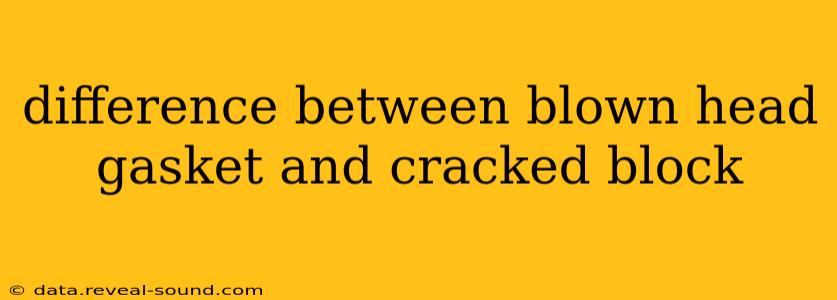Internal engine damage can be a costly and frustrating experience. Two common culprits are a blown head gasket and a cracked engine block. While both can lead to significant engine problems, understanding the differences is crucial for accurate diagnosis and effective repair. This article will delve into the distinctions between these two issues, helping you understand the symptoms, causes, and necessary repairs.
What is a Blown Head Gasket?
A head gasket is a crucial component that seals the space between the engine block and the cylinder head. It prevents coolant and oil from mixing and ensures proper compression within the cylinders. A blown head gasket occurs when this seal fails, allowing fluids to leak or mix. This often results in a loss of compression, leading to a significant reduction in engine performance.
Symptoms of a Blown Head Gasket
Several symptoms point towards a blown head gasket, including:
- White smoke from the exhaust: This indicates coolant is entering the combustion chamber.
- Overheating: A blown head gasket can disrupt the cooling system's efficiency.
- Oil contamination with coolant (milky oil): The mixing of oil and coolant is a classic sign.
- Coolant loss: Coolant leaks can be external or internal, depending on the location of the failure.
- Loss of compression: This leads to a noticeable drop in engine power and rough running.
- Bubbles in the radiator: Pressurizing the cooling system may reveal bubbles, indicating exhaust gases are entering the coolant.
What is a Cracked Engine Block?
The engine block forms the foundation of your engine, housing the cylinders and other critical components. A cracked engine block is a serious issue where a fracture develops within the block itself. This can be caused by overheating, corrosion, or even a physical impact. A cracked block compromises the structural integrity of the engine, resulting in significant and often irreparable damage.
Symptoms of a Cracked Engine Block
Identifying a cracked engine block can be more challenging than spotting a blown head gasket. Symptoms can include:
- Coolant leaks: These may be external or internal, often appearing near the crack itself.
- Overheating: Similar to a blown head gasket, a cracked block interferes with proper cooling.
- Loss of compression: This can be inconsistent, depending on the location and severity of the crack.
- External cracks visible: In some cases, particularly with older engines or those subjected to significant damage, cracks may be visibly apparent.
- Low oil pressure: A crack near an oil gallery can lead to oil leaks and reduced pressure.
What is the difference between a blown head gasket and a cracked block?
The fundamental difference lies in the location of the failure. A blown head gasket affects the seal between the cylinder head and the engine block, while a cracked block involves a fracture within the engine block itself. A blown head gasket is often repairable through replacement, whereas a cracked block frequently necessitates significant engine repair or replacement.
Can a cracked block be repaired?
While some minor cracks might be repaired through welding or specialized epoxy, extensive cracks often render the engine block irreparable. The repair's success also heavily depends on the location and size of the crack. Often, the cost of repair exceeds the value of the engine, making replacement a more practical solution.
Can a blown head gasket be repaired?
A blown head gasket is generally repairable by replacing the faulty gasket. This involves removing the cylinder head, cleaning the mating surfaces, and installing a new gasket. This is a more straightforward repair than fixing a cracked block.
How are these problems diagnosed?
Diagnosing both issues requires a combination of visual inspection, pressure testing (coolant and compression), and potentially, specialized leak detection techniques. A professional mechanic is usually needed for a precise diagnosis, particularly to distinguish between a blown head gasket and a cracked block.
Frequently Asked Questions (FAQs)
What causes a blown head gasket?
Overheating is a primary cause, along with extreme engine stress, improper maintenance (neglecting coolant), and age-related wear and tear.
What causes a cracked engine block?
Overheating is the most common cause. Other factors include corrosion, physical impacts, and manufacturing defects.
How much does it cost to repair a blown head gasket?
The cost varies greatly depending on the vehicle, labor rates, and any additional repairs needed.
How much does it cost to repair a cracked engine block?
Repairing a cracked engine block can be incredibly expensive, often exceeding the cost of a replacement engine.
How long does it take to repair a blown head gasket or a cracked block?
Repair time varies depending on the complexity of the repair, vehicle type, and mechanic availability. A blown head gasket repair can take several hours, while a cracked block repair or replacement might take days or even weeks.
In conclusion, both blown head gaskets and cracked engine blocks signify severe engine problems requiring professional attention. While a blown head gasket is usually repairable, a cracked block often necessitates extensive or complete engine replacement. Early detection and prompt action are crucial in minimizing damage and repair costs.
